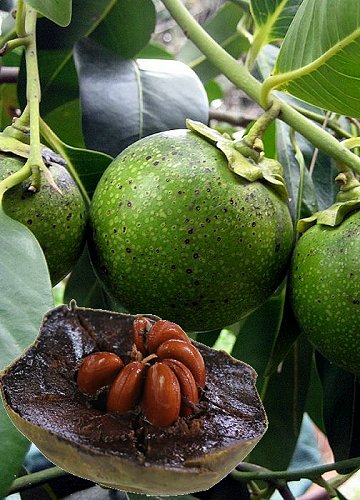
|
|
Black Sapote
(Diospyros nigra).
|
Black Sapote - Diospyros nigra
Diospyros nigra or Diospyros digyna, the black sapote, is a species of
persimmon family. Common names include chocolate pudding fruit, black soapapple and (in Spanish) zapote prieto. The tropical fruit tree is native to Mexico, Central America, and Colombia. The common name sapote refers to any soft, edible fruit. Black sapote is not related to white sapote nor mamey sapote.
Mature trees can grow to over 25 m in height, with trunk diameter of up to 45
cm and are evergreen. It is frost sensitive but can tolerate light frosts.
They have a rounded crown and black bark. The leaves are elliptic-oblong, tapered at both ends, dark green, glossy and 10–30 cm (3.9–11.8 in) long. Some trees bear only male flowers. Others have both male and female flowers, though some of these are self-incompatible.
The plant is not self-fertile. The white flowers are borne in the leaf axils and about 1-1.6 cm in diameter.
Fruiting takes about 3–4 years from seed and the trees are heavy bearers.
Black sapote fruit are tomato-like and measure 5–10 cm in diameter, with an inedible skin that turns from olive to a deep yellow-green when ripe and a pulp which is white and inedible when unripe but assumes a flavor, color and texture often likened to chocolate pudding when ripe. Fruits usually contain seeds, up to a maximum of 12. The texture has been likened to that of a papaya. Charles R. Boning (2006) describes the ripe fruit as having "the taste and consistency of chocolate pudding".
Propagation is usually from seed, which can retain viability for several months and require around 30 days for germination. Some trees are seedless however, and can be propagated by air-layering or shield
budding.
Black sapote trees are normally found below 600 meters, but are not particular about soil, and can tolerate light frosts. They are sensitive to drought, requiring irrigation in dry areas, but are quite tolerant of flooding. The tree grows fairly slowly for the first 3–4 years, perhaps just 1 foot/year for the first couple of years. Later however it grows much more rapidly. Trees should be spaced 10-12m apart.
The tree’s thick, glossy foliage and interesting fruit has led to it being cultivated in South Florida, Hawaii, and the Philippines, outside of its native range in Central America.
Fruits are harvested when mature, and left to ripen. The fruit turns a duller colour when ripe and the persistent calyx at the base, which is pressed against the developing fruit, becomes reflexed. At this stage the fruits are still firm. They soften 3 - 14 days after harvesting, individual fruits ripening suddenly and unpredictably within 24 hours.
The fruit is edible raw or cooked. Bitter and astringent when unripe, it should not be eaten until it is fully ripe and soft. Mature fruits are consumed fresh or made into ice cream and desserts. They are also used in drinks and
liqueurs. Soft, rich, dark chocolate brown in colour and somewhat sweet. The black mushy flesh is repulsive in appearance, reminding one of dirty axle grease. Rather bland, the fruit is best mashed with a little orange, lemon or lime juice and chilled before
serving.
The fruit is rather boring on its own, but delicious when used in smoothies, jams etc. South Floridians often blend the pulp with milk and cinnamon and freeze it to make ice cream. In the Philippines, the fruit is served with a splash of orange juice. Throughout Mexico, the pulp is mashed and mixed with brandy or wine to make a pudding-like dessert.
The immature fruit can be boiled and used as a vegetable.
Unripe fruits are astringent, caustic, bitter, irritating, and have been used as fish poison in the Philippines.
The wood of Black Sapote is yellowish to deep-yellow with black markings near the heart of old trunks; it is compact and suitable for cabinetwork, but is little
used. The wood is reported to have the qualities of typical ebony.
Source:
https://en.wikipedia.org/wiki/Diospyros_nigra
https://pfaf.org/User/Plant.aspx?LatinName=Diospyros+digyna
https://ambergriscaye.com/photogallery/190517.html
